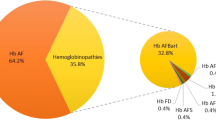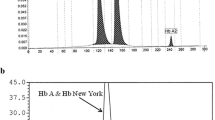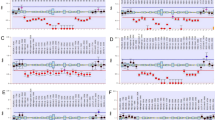Abstract
Various hemoglobinopathies have been reported from Pakistan excepting the rare ones like hemoglobin Q India. Our purpose of study was to identify the mutation (α 1 64 aspartate to histidine) through amplification restriction mutation system-polymerase chain reaction (ARMS-PCR) in patients where hemoglobin Q has been detected via high performance liquid chromatography (HPLC) and also to evaluate the cost effectiveness of the two technologies. All patients irrespective of age and gender who underwent HPLC for identification of their hemoglobin variant during January 1, 2006 to January 30, 2007 were studied. The blood samples with unknown peak at a retention time of 4.7 min were evaluated at the molecular level. Analysis of HPLC tracings of 11,008 subjects over a thirteen-month period identified ten individuals with hemoglobin Q. Male to female ratio was 1:1.5 and their age was variable ranging from 1 to 49 (mean 22.8) years. The mean hemoglobin level was 11.3 g/dl while MCV (fl) and MCH (pg) were 73.0 and 20.8 respectively. HPLC showed an unknown peak of 17.7% which was detected as Hb Q. ARMS based PCR showed Hb Q specific product of 370 bp and also an amplified product of 766 bp as the control fragment in these samples. This is the first ever report that documents the presence of Hb Q India (α 64 Asp to His) in Pakistani population. We recommend that HPLC be used as a useful screening tool especially in developing countries where PCR facilities may not be accessible.


Similar content being viewed by others
References
Wiwanitkit V (2005) Phylogenetic tree of hemoglobin Q disorders. The Internet J Hematol 2(1):1–4
Dash S, Huisman TH (1988) Hemoglobin Q India (64 (E13) Asp–His) and beta thalassemia: a case report from Punjab (North India). Eur J Hematol 40:281
Luan Eng LI, Pillay RP, Thuraisingham V (1966) Further cases of Hb Q-H Disease. Blood 28(6):830–839
Nigam PK, Sharma S, Sareen R, Paul V, Lal A (2006) Lack of precision in HbA1c values on variant II in cases of hemoglobin Q India. Ind J Clinic Bioch 21(2):72–75
Desai DV, Dhanani H, Kapoor AK, Yeluri SV (2004) Hb Q-India in a Sindhi family: an uncommon hemoglobin variant. Lab Hematol 10:212–214
Abraham R, Thomas M, Britt R, Fisher C, Old J (2003) Hb Q India: an uncommon variant diagnosed in three Punjabi patients with diabetes is identified by a novel DNA analysis test. J Clin Pathol 56:296–299
Fuchareon S, Winichagoon P (1987) Hemoglobinopathies in Southeast Asia. Hemoglobin 11:65–88
Wiwanitkit V (2006) Secondary and tertiary structure aberration of alpha globin chain in hemoglobin Q-India disorder. Indian J Pathol Microbiol 49(4):491–494
Sukumaran PK, Merchant SM, Desai MP, Wiltshire BG, Lehmann H (1972) Haemoglonin Q India (α 64(E13) aspartic acid–histidine) associated with β-thalassemia observed in three Sindhi families. J Med Genetics 9:436–442
Panigrahi I, Bajaj J, Chatterjee T, Saxena R, Mahapatra M, Pati HP (2005) Hb Q India: is it always benign? Am J Hematol 78:245–247
International Committee for Standardization in Hematology (1978) Simple electrophoretic system for presumptive identification of abnormal hemoglobins. Blood 52(5):1058–1064
Dash S, Huisman TH (1988) Hemoglobin Q India (64(E13) Asp–His) and beta thalassemia: a case report from Punjab (North India). Eur J Haematol 40:281
Sagnet H, Morineaud JP, Delprat J et al (1968) A rare hemoglobinosis: the association of hemoglobin Q and alpha thalassemia. Med Trop (Mars) 28:133–138
Qin WB, Baysal E, Wong KF et al (1994) Quantities of αQ chain variant in heterozygotes with and without a concomitant β-thalassemia trait. Am J Hematol 45:91–93
Author information
Authors and Affiliations
Corresponding author
Rights and permissions
About this article
Cite this article
Moiz, B., Moatter, T., Hashmi, M.R. et al. Identification of hemoglobin Q India (α 1–64 Asp–His) through ARMS-PCR. First report from Pakistan. Ann Hematol 87, 385–389 (2008). https://doi.org/10.1007/s00277-007-0431-2
Received:
Accepted:
Published:
Issue Date:
DOI: https://doi.org/10.1007/s00277-007-0431-2




